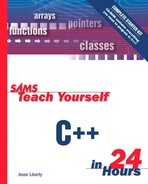Understanding Function Headers and Prototypes
Listing 11.7 shows swap() using pointers, and Listing 11.8 shows it using references. Using the function that takes references is easier, and the code is easier to read; but how does the calling function know if the values are passed by reference or by value? As a client (or user) of swap(), the programmer must ensure that swap() will in fact change the parameters.
This is another use for the function prototype. By examining the parameters declared in the prototype, which is typically in a header file along with all the other prototypes, the programmer knows that the values passed into swap() are passed by reference, and thus will be swapped properly.
If swap() had been a member function of a class, the class declaration, also available in a header file, would have supplied this information.
In C++, clients of classes (that is any other class's method using the class) rely on the header file to tell all that is needed; it acts as the interface to the class or function. The actual implementation is hidden from the client. This enables the programmer to focus on the problem at hand and to use the class or function without concern for how it is implemented.
